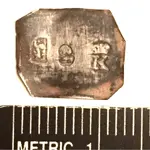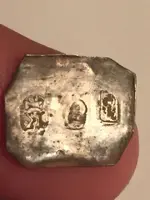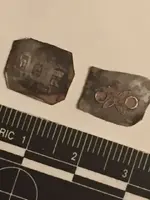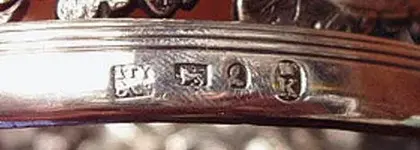I was intrigued by the design on the second (non-hallmarked) piece and in deciding to search about Silver Trade pieces during the 1700's, I found the article at the link below very interesting. I also copied and pasted several paragraphs below and highlighted the last copied and pasted paragraph as I found it especially interesting. I am not saying that the O.P's second Silver piece is an identification badge worn by a friendly Native American Indian but it is something to look into!
http://digitalcommons.buffalostate.edu/cgi/viewcontent.cgi?article=1233&context=neha
Badges, "peace medals," and similar presentation pieces in silver are known from at least the 1660s in Virginia (Gillingham 1927:99), and silver armbands may have been used by natives before 1740 (Woodward 1932: 17). However, the array of ornamental sterling silver items generally known as "trade silver" was not a significant part of Native American interactions in the northeast until about 1750 (cf. Gillingham 1934). Quimby (1966: 91) suggests that "Such ornaments were not used in the western Great Lakes fur trade before 1760." Why was there a "delay" of more than 200 years after the earliest European contacts along the east coast before silver goods became significant in the Native-European trade?
Roger Williams (1643) was not the only observer to note that Native Americans had no regard for items of gold and silver. Williams points out that they retained their own symbolic forms to express their individual and specific cultural identities. About 1626 Isaack de Rasieres (James 1963: 69-70) also noted that the natives valued only wampum, and "they consider it as valuable as we do money here." Both Robert Beverley (1725, 3: 58) and Francis Michel (1916: 134) noted similar avoidance of gold and silver among the Indians of Virginia (cf. Thwaites 1896-1901, 5: 60-61). As late as 1748 Peter Kalm (1987: 343) noted that "for the Indians [wampum] is their ornament and money," but also indicated that no natives were producing this commodity at that time.
This pattern is particularly interesting when we consider that other categories of European-produced goods, such as pottery and weapons, rapidly replaced or augmented native-made items. The evidence suggests that despite extensive European contact and specific modifications in material culture, the Lenape (and possibly many other native peoples: cf.Bradley 1987) continued to maintain control of their decision-making abilities concerning social, political, or territorial matters for over 100 years after regular and intense contact with Europeans (see Newcomb 1956). Lenape identity was maintained by language use and marriage patterns, as well as through traditional means of ornamentation, and parallelisms appear likely among other native groups (cf. Hickerson 1992; Sattler 1992).
Martha McCartney (1984) discusses the origins and native use of "copper or silver" identification badges in the Potomac region after 1662. Friendly natives were to wear these badges, or other indicators of their position, when entering into areas ceded to the colonists. These large badges as well as presentation medals were in common use by 1700 (Gillingham 1936; Becker 1983b). As late as 1755, Indians in New Jersey had to register, carry a pass, and wear a red ribbon to indicate their friendly status (Ricard 1891: 567).









